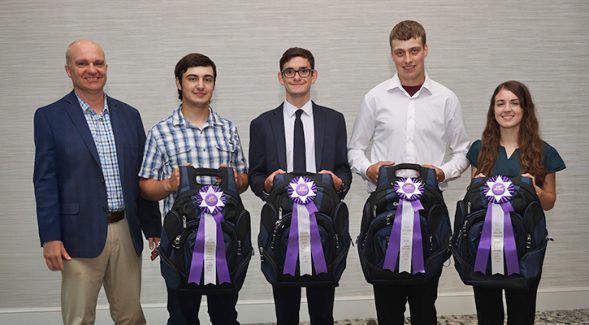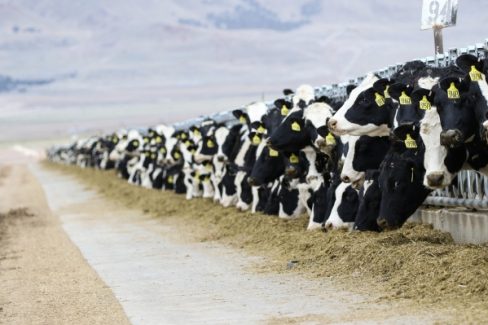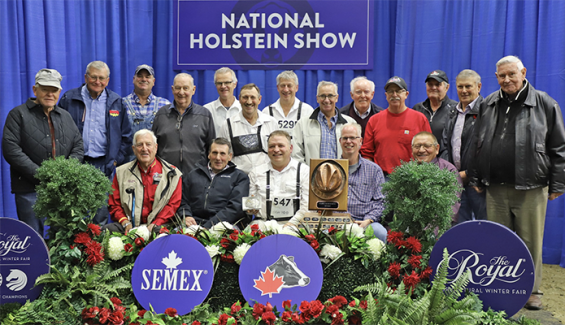It’s one thing for a doctor to tell a farmer to give up milking. Quite another is thinking that it will take the milk from a lifelong dairyman’s veins. That seems to be the case, at least, for retired dairy farmer Larry D. Roth, whose father in 1940 began a dairy operation that today is managed by a third generation.
Back and shoulder problems a quarter century ago forced him from the rigors of daily milking.
But that hasn’t kept him off the farm entirely.
“I like to go over and help,” Roth said. After all, there’s more to do on a dairy farm than just milking the cows.
Another way Roth stays connected to dairy farming is the two days each week he can be found at Midwest Memories Museum and Shoppe, where his collection of glass milk bottles is the star attraction. Three years ago, the Wayland Museum moved its collection into the Main Street storefront across from City Hall, adding sports trophies, class photos, old newspapers and other community memorabilia among tools and souvenirs of the dairy industry.
Prior to suggesting the move to city officials, Roth said the Wayland Museum was open to the public just an hour a year, following the annual Independence Day parade.
The Hawk Eye reports that despite the municipal involvement, it’s still Roth’s museum.
The city splits the overhead costs for the rented museum space, and Roth serves on the city’s museum committee — of which he is the sole member. And although the city clerk technically is head of the Wayland Museum and is called upon to make decisions about accepting any artifact donations, on days when the museum is open — most Tuesdays and Thursdays throughout the year — Roth is the lone volunteer.
He’s also what passes for curator.
A stack of old copies of a Wayland newspaper dating to the late 19th century lie in stacks atop a display case, waiting to be cut up for scrapbooks — one for interesting news items, another dedicated to advertising by Wayland businesses.
What he does not profess to be is the lone keeper of local history.
“There are some older people that really know much more,” he said.
Roth is merely the one who had the gumption to open a museum, thanks in part to a little encouragement at home.
Although she helped get the building ready, Roth’s wife of 54 years, Mary Lou, made it clear early on the museum would be his and his alone. Perhaps her biggest contribution was the motivation to exhibit his collection.
“It got to the point,” Roth said, “where my wife said, ‘You’re either going to sell them, or display them,’ and I wasn’t ready to sell them.”
The former dairyman didn’t go directly from farm to museum, though. He started and ran a feed store for a while, then spent the 1990s in Ohio, moving close to his ailing mother-in-law and working a couple of different jobs before returning to Iowa in 2001. It was four more years, he said, before he truly retired.
With the addition of the city museum’s collection, Roth had to remove some of his own things to make room.
“I had this clear full of everything of my own,” he said, standing amid shelves and display cases brimming with milking memorabilia on a frigid January morning, waiting for the furnace to warm the place up for the day. “I sold, gave away or boxed up half of it make room.”
None of his milk bottles or other industry artifacts were part of the mass exodus.
There are milking stools and milking machines, milk cans, glass creamer bottles, antique ice cream dippers and a hand-crank ice cream-maker; advertising and promotional products from dairies, milk delivery boxes and milk crates and dozens upon dozens of bottles.
Each bottle, from large to small, is filled with white Styrofoam beads to give the appearance of having milk in them. Long-defunct local dairies, including Sunshine and Gustafson Bros. from Burlington, and from around Washington, Iowa, are on display.
Some are of embossed glass, but most are lettered using a process called pyroglazing that came into use in the 1930s.
The most collectible are round, pyroglazed, quart-sized bottles with no chips or cracks.
A pair of racks features a single quart bottle from each of the lower-48 states. Iowa is represented by Maple Lawn Dairy of Keokuk. Alaska and Hawaii are missing, mainly because examples Roth has found on eBay were selling for more than he wanted to pay. With luck, an anniversary trip planned later this year to Hawaii — Roth’s older brother, Royce, will mind the museum — can help fill in that blank.
Other than hoping to one day complete the 50-states collection, and accepting the occasional donation, Roth doesn’t haunt antique stores anymore, looking for unique buys.
Few would make note of any changes, anyway. The museum doesn’t get a lot of foot traffic. On a weekly basis, visitors usually include friends who drop by to shoot the breeze. Otherwise, it’s mainly locals who moved away and are back in town to see family. The museum still is open after the parade July 4.
Maintaining a small town museum isn’t the only thing keeping Roth occupied in his retirement. There’s still the farm, plus attending his grandchildren’s activities, travel and volunteering with a variety of other organizations, including as a resident advocate at Parkview retirement home in Wayland.
Door-to-door fundraising for CROP and involvement in Gideons International are among other pursuits.
There’s also, he said, helping to coordinate a historical survey of Wayland and Jefferson Township residents looking for interesting, and unknown, tidbits about people and properties that could lead the city to get its first building on the National Register of Historic Places.
Source – Dairy Today




